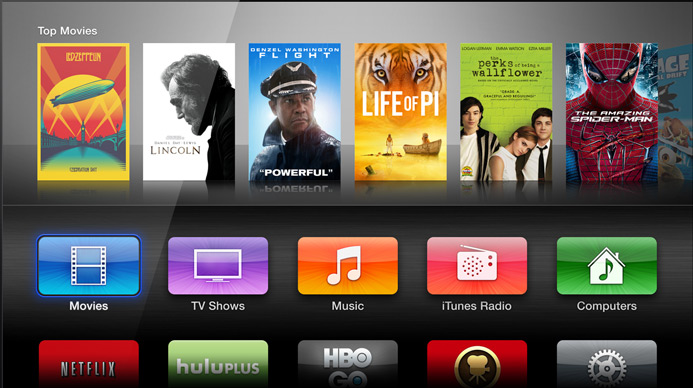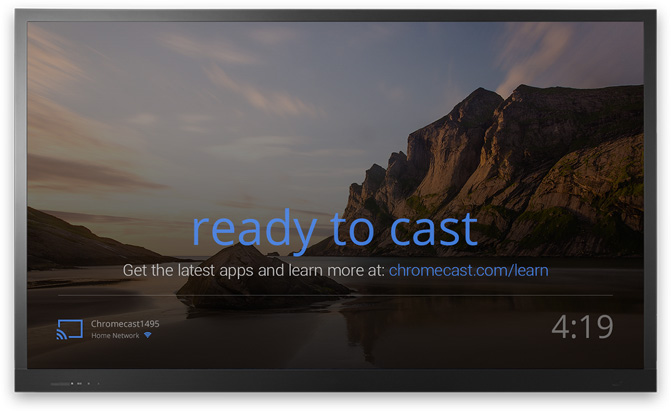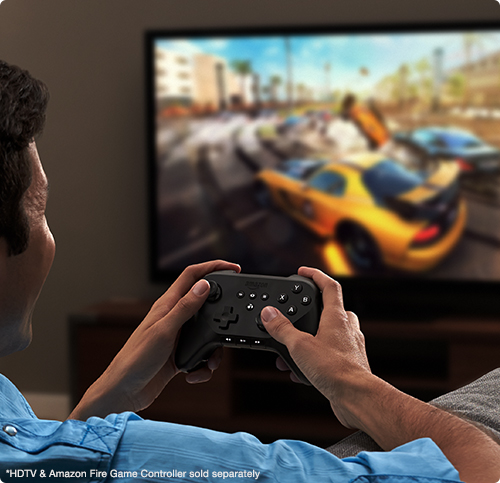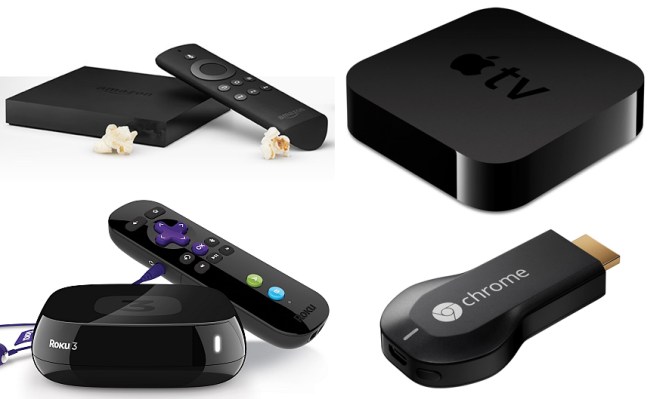Amazon has just announced its streaming TV media device, the Fire TV, and that means it now faces off against other tech giants and incumbents in yet another category. So how does the Amazon TK compare to the likes of the Apple TV, Google’s Chromecast and Roku’s lineup of streaming set-top boxes and new HDMI stick? Here’s a basic rundown.
First-Party Content
Amazon has a considerable leg up here; its Amazon Instant Video library is large and covers a wide range of different types of content from top-notch sources. The company just looked down exclusive rights to streaming Fox hit 24, for instance, and Amazon has invested in creating originals, too, with more to come for both videos and games. Plus, Amazon also offers access to its MP3 store and user libraries from there. The catch here is that for free access to Instant Video, you’ll need to be a prime subscriber, which carries a price tag of $99 per year.

Apple TV offers probably the biggest catalog in terms of first-party content thanks to iTunes music, movie and TV content. These basically span the range of what you’d want to see or hear, and the libraries are available in more markets around the world than those of their competitors. But there’s a catch; while iTunes Radio offers access to free streaming music in a couple of places, in most you’ll have to purchase content piecemeal, meaning the price tag is going to be a lot higher than $99 per year to get access to the same depth of library as you have on Amazon.
Google offers Play Music and Play Movies to its users, including a streaming radio option, but the content library falls just short of Apple’s, and is more geographically restricted. Also, like with iTunes, there’s no all-you-can-eat video option.
Roku relies heavily on third-party sources for its content, which brings us to the next area of comparison.
Third-Party Services
This is an area of growing import for these devices, which arguably began life as a way to get users to invest more heavily in a specific ecosystem, but which have shifted into a way to get people access to their content wherever it is.
 The Chromecast is fast-becoming the best way to do this, with third-party developers announcing support for the streaming stick frequently, and an advanced SDK promising more sophisticated integrations to come. But you’ll still need a host device to make this work, meaning a smartphone, tablet or desktop computer.
The Chromecast is fast-becoming the best way to do this, with third-party developers announcing support for the streaming stick frequently, and an advanced SDK promising more sophisticated integrations to come. But you’ll still need a host device to make this work, meaning a smartphone, tablet or desktop computer.
Apple TV also has strong support for third-party services – via AirPlay, its streaming protocol that allows you to beam content from your Mac or iOS device to your TV. Apple has increasingly been adding native apps to the Apple TV to bring third-party content to the platform, too, and while it’s slower than if there was an open SDK, those attempts are also picking up, and deepening the library of third-party services. Netflix has long been a key part of that offering, and it remains so even now.
Roku is all about third-parties, and it offers a sizeable Channel Store as well as built-in third-party apps to prove it. Netflix is a key player here, as is Amazon Instant Video, and in general Roku has an advantage here because it has no agenda in terms of promoting its own libraries or content stores. It’s more flexible than Apple when it comes to third-party partners, and less so than Google’s Chromecast, but with more curation and an experience that doesn’t require a separate host device.
Amazon paid a lot of lip service to third-party openness during its presentation today, and it has all the big services already signed on, with many more partnerships to come and what looks like a very developer-friendly platform. Roku has the lead for now, but Amazon’s Fire TV will probably catch up pretty fast.
Gaming
Another exciting emerging area for these devices is gaming. Chromecast looks like it will soon support some innovative game concepts with Android devices, but it’s early yet to tell. Roku has added games, including Angry Birds and many others, but most of these are fairly uninspired mobile ports, and isn’t made for gaming.
Apple TV supports gaming, but in a roundabout way. It does so by offering access to AirPlay for third-party devs who want to create gaming experiences that incorporate both the big screen and iOS devices. In practice, this has produced some interesting two screen games, but it has yet to reach maturity and really take off as a medium. Apple providing access to native gaming software on the platform itself would be a nice addition, and has been suggested by some rumors.

Amazon looks to be going all-in on gaming with the Fire TV. It made it very easy to port titles, as mentioned, and it also offers its gaming controller accessory for $40. It has its own gaming development studio, and it has partners across the range of small-time indie devs to big, marquee studios. The proof, as they say, will be in the pudding of how fun these games are to play, but Amazon hasn’t just tacked this on as an afterthought, based on the nature of their announcement.
Size And Power Requirements
The Chromecast takes the cake here, as a small HDMI dongle that can use your TV’s USB port for power, if it has one, and requires no additional cables or power sources. Likewise, Roku’s new streaming stick offers the same basic design.
Apple TV and Roku’s other boxes have a more traditional power cable, and also take up a bit more space, requiring a cabled connection to the TV itself for HDMI hook-up. The Apple TV does offer an Ethernet port, though, as well as an optical audio line out.
Amazon’s set-top box is also a set-top box, not a dongle, but it’s extremely small, and offers Ethernet, USB, HDMI and optical audio connections, plus it supports a remote and has 8GB of built-in storage. The trade-offs in terms of size of device seem well worth it.
Ease Of Setup And Use
These devices are all fairly plug-and-play. Chromecast is easy in some ways, with its app-driven setup, but it requires you switching Wi-Fi networks and downloading an app, whereas the Apple TV just asks you to do a lot of virtual keyboard typing with a limited remote.
Amazon lists its process as plug-and-play, with three steps to get started. Instant playback with no loading time is another key advantage here, even if it’s just a small one.
Price
The Apple TV is $99, and the Rokus range from $50 to $100. Google’s Chromecast is just $35, but it also doesn’t operate as a standalone device like the others do. Amazon’s Fire TV is $99, which could be a big ask given Google’s low ball alternative, but it does appear to be a much more full-featured platform out of the gate. Amazon is clearly hoping that it can convince consumers it does more for the same cost as its more direct competitors like the Roku 3 and Apple TV. The presentation definitely made it seem like it has some advantages in terms of UI, original content and games, but we’ll have to wait and see how useful those differentiating factors are in practice.
